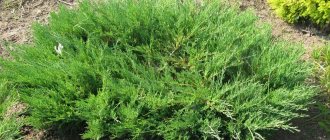Coreopsis is a genus of herbaceous plants from the Asteraceae family. The name of the flower is translated from Greek as “bug-like.” This is due to the fact that the seeds have an external resemblance to these insects. Coreopsis is also called “Parisian beauty”, “lenko”, “girl’s eyes”. The genus includes more than 100 species, both annual and perennial.
Perennial coreopsis are widely used for outdoor cultivation. These are unpretentious flowers that can become the central decoration of any area, thanks to their color diversity. Unlike annuals, perennial coreopsis are hardier and do not require annual renewal.
Varieties and types of perennial coreopsis
This plant is a shrub with erect, branched stems on which inflorescences with flowers of different shades are formed. Among the many varieties of coreopsis, no more than 30 have been cultivated. And there are even fewer perennials among them. Let's look at common types of coreopsis for home growing.
Large-flowered
The plant is up to 1 m high. The stems are highly branched, the lower leaves are entire, dissecting closer to the top. The flowers are yellow, about 7 cm in diameter. Blooms for 2 months, starting in June.
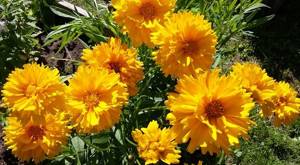
Lanceolate
Subshrub about 60 cm high. Flowers are yellow, about 6 cm in circumference. Flowering begins in July.
Popular varieties:
- Sterntaler,
- Tequila Sunrise.
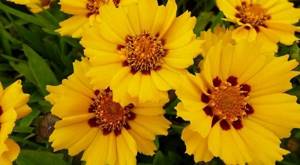
Whorled
Densely branched subshrub up to 1 m high. Leaves are narrow, needle-shaped. The flowers are yellow or orange. The species blooms almost all summer.
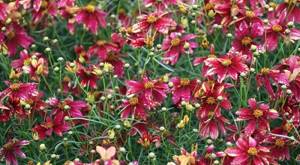
Pink
The plant is up to 40 cm high. The stems are branched and form a lush shrub. The flowers are small and pink. There are two-color varieties (Sweet Dream).
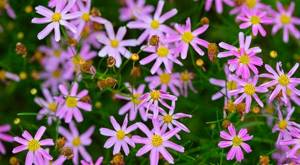
Dyeing
A highly branched species with a height of about 1 m. Although there are also low-growing varieties. The inflorescences are small, about 5 cm. The outer side of the petals is yellow, the inner side is brown.
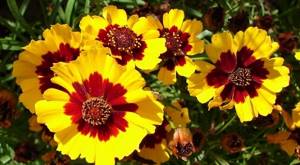
Using coreopsis in landscape design
A plant with a long flowering period is a wonderful decoration for borders and flower beds. Varieties with tall stems will become a bright carpet in collaboration with annuals. They are usually planted in groups or as a background for other flowers.

Squat species are designed for planting in containers outside windows. The use of coreopsis flowers when decorating a small area or a narrow long courtyard in a Mediterranean style is considered effective.
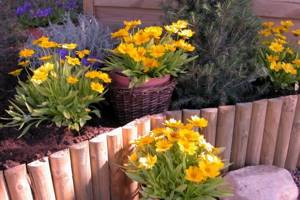
A good solution could be to plant flowers along the boundaries of the site or create miniature flower beds between paved paths. Containers of various shapes and sizes with flowering plants, simply placed or hung in the yard.
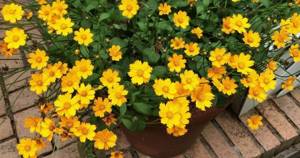
Such a garden does not require maintenance, and a bright flower refreshes the area, fills it with color, makes a joyful impression and creates a wonderful mood.

Yellow daisy goes well with many flowers; it looks great against the backdrop of dahlias, irises, roses, and stocky species benefit from delphinium and petunia.
Growing seedlings
Most gardeners prefer to grow coreopsis from seeds. In order for the plant to bloom in the first year, it is recommended to pre-sow the seeds for seedlings. The seedling method is also recommended for breeding rare varieties of coreopsis. It is best to sow seeds for seedlings in March or April.
Container and soil
First prepare containers for seedlings. These can be separate pots, plastic cups, containers. They must have drainage holes for free penetration of moisture. Earth mixture for planting: sand and garden soil (1:1). Fill the container with it and moisten well.
Sowing and caring for seedlings
Spread the seeds thinly over the surface of the moist substrate. Press them lightly and sprinkle with sand. Lightly moisten the soil again. Cover the container with film and place in a warm, bright room. Remove the film regularly for ventilation and watering. After germination, it can be removed altogether.
Plant the seedlings into separate pots after 2-3 true leaves appear. When there are 5-6 leaves, the seedlings need to be picked again. You can avoid repeated transplants if you immediately sow the seeds at a distance of 10-15 cm from each other. At the same time, we must not forget that 100% germination is rare.
Transplanting
Starting from the beginning of May, seedlings can be gradually taken outside for hardening. You cannot immediately place it in the open sun; it is better to choose a shaded place. When the weather is finally warm (around the end of May), the seedlings can be planted outside.
Dig holes in the prepared area. Their depth should be slightly larger than an earthen ball with roots. The distance between tall species of coreopsis should be about 30 cm, between short ones - 15-20 cm. Place drainage (gravel, expanded clay) in each hole to avoid moisture stagnation. Sprinkle some soil on top and moisten it. Carefully remove the seedlings from the container without disturbing the earthen ball. Move it into the holes. Sprinkle with soil and compact it a little with your hands. Water the plant generously.
Growing perennial coreopsis from seeds
Planting and care in this case are the simplest and most effective, because The crop is easily propagated by seeds. However, it is best to use seed material purchased from a reliable manufacturer, since seeds collected independently may not inherit the characteristics of the variety. You can also use the seedling method if you want to see flowering this year.
Seeds for seedlings should be sown in March. Sowing is carried out without deepening, on a moistened substrate. The top of the container is covered with film or glass to speed up germination.
If there is a sufficient amount of seed material, you can do without picking, simply cutting off the weaker shoots with scissors. The seedlings will be ready for transplanting into open ground when the threat of frost has passed. But, if you harden the seedlings gradually, the cold-resistant flax will easily withstand quite long nighttime drops in temperature.
When transplanting to a permanent place in open ground, it is necessary to leave at least 50 cm between seedlings, because in the future they will actively grow.
Planting seeds in open ground
If it is not possible to grow seedlings, seeds can be sown directly in open soil. But you need to take into account that with this method of planting, flowering will occur only next year.
Deadlines
Perennial coreopsis is quite cold-resistant. Its seeds have good germination if sown in autumn. When planting in open ground in spring, they are sown only after warm weather has established (depending on the region, this may be the end of April - the beginning of June). But when planted in spring, the plants lag significantly behind in development from those sown before winter.
Selecting a location
Coreopsis is also called “sunny daisy”. Therefore, you need to choose a well-lit place to plant it. Only in this case will the plant delight with lush flowering. In the shade, coreopsis will not only bloom worse, but may even wither away. In addition to good lighting, when choosing the location of a plant, you should focus on the intended floral composition. Low-growing species are recommended to be planted along flower beds and garden paths. It is better to move tall shrubs to the back of the flower garden.
Landing rules
Before sowing seeds, you need to prepare the area. The soil for the full growth of coreopsis must be loose and fertile. The area should first be dug up. Add compost or sand to the soil if it is not loose enough.
Plant the seeds in moist soil to a depth of 1 cm and water. At first you can sow them quite densely. Subsequently, the seedlings can be planted at a distance of 20-40 cm from each other, depending on the variety. If there is still a threat of frost, the area can be covered with film or agrofibre at night. This will also help maintain constant humidity and speed up germination.
Planting a plant
This flower prefers well-lit areas, but in the shade it begins to wither, gets sick a lot and loses its decorative effect. Medium-fertile, light soils are ideal for planting. But loamy and sandy soil must be additionally fertilized with humus and a large amount of peat added.
It is best to plant perennial coreopsis with seeds. This will allow the plant to bloom literally a few months after planting. The technology of planting perennial coreopsis in boxes or pots in winter is also popular among gardeners. Subsequently, the seedlings are transferred to open ground in early May, when the danger of frost has already passed.
Coreopsis seeds can be planted in open ground in spring and autumn . These plants can easily tolerate low temperatures, and all planting care will consist only of regular thinning of the bushes and removal of weeds that can cause various bacterial diseases. The gardener will need to ensure regular watering, since plants grow poorly in dry soil and lose their decorative properties.
Outdoor care
Coreopsis is an unpretentious plant, but for normal development it needs to create certain conditions.
Watering
The flower can tolerate drought. But for full growth it is better not to let the soil dry out. If precipitation is normal in summer, then coreopsis does not need additional watering. It should be watered only in dry weather. But you can’t flood the bush so that the roots don’t start to rot.
Feeding and fertilizer
Perennial coreopsis needs to be fed very carefully. With an excess of nitrogen-containing fertilizers, the plant can greatly increase its green mass and stop blooming. It is better to use organic matter for feeding. The ideal option is compost (35 g per 1 m2). It is recommended to apply the first fertilizing when planting the plant in open ground. Fertilize the bush a second time during flowering. In the absence of compost, you can apply complex mineral fertilizers for flowering plants.
Care during flowering and pruning
When coreopsis blooms, you need to regularly monitor it and trim off faded flowers.
This stimulates the formation of new inflorescences. It is recommended to trim all stems in the fall before the onset of the dormant period. Warning! It is strictly forbidden to prune the large-flowered variety of coreopsis. In this case, it may not survive the winter.
Caring for coreopsis in the garden
Rules of care
Even novice gardeners can grow coreopsis. What is plant care? You will need to water the coreopsis from time to time, loosen the soil around it, and remove weeds and wilted heads. Tall species and varieties of coreopsis may require support: stick an iron rod or wooden peg next to the bush and tie the plant to it.
How to grow rudbeckia - a relative of coreopsis
After flowering is completed, coreopsis is cut to a quarter of its height, and before the onset of frost, annual species of the plant are completely disposed of, and perennials are cut back to the very base. You don’t have to cover coreopsis for the winter, but if the forecast is for a frosty, snowless winter, it is still advisable to cover the perennial rosettes with fallen leaves or cover them with dry soil.
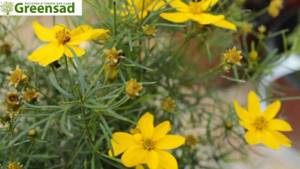
Perennial coreopsis grows quickly, so once every 4-5 years in April-May or September its bushes are dug up, divided and planted in another area. Even flowering coreopsis can be divided, however, in order not to damage its roots, the divisions should be planted only in well-moistened soil.
Watering and fertilizing
Strong coreopsis is not afraid of drought, and only seedlings need regular watering. In the future, under normal rainfall conditions, there is no need to water the plant.
But if the season turns out to be too hot and dry, you will have to moisten the soil in the area from time to time with water heated in the sun.
Coreopsis growing in poor soil during the flowering period is fed with a solution of complex mineral fertilizer. If it grows on fertile soil or if you applied organic fertilizers to the site before planting the seedlings, there is no need to feed coreopsis this season, but next year you will need to apply fertilizers twice: when the coreopsis blooms and after its autumn pruning.
- Gladiolus is a symbol of courage and nobility
How to plant and grow beautiful gaillardias
Pests and diseases
During the rainy season or as a result of frequent and abundant watering, coreopsis may suffer from fungal infections - rust, spotting or fusarium. Signs of the disease usually appear on the leaves. The affected foliage must be removed and the bushes treated with fungicidal preparations, which can be purchased at any garden pavilion or flower shop.
If the damage to the bush is too significant or the flower stalks of the plant begin to curl into a tube, which is a sign of an incurable viral infection, you must immediately remove the diseased specimen and be sure to burn it.
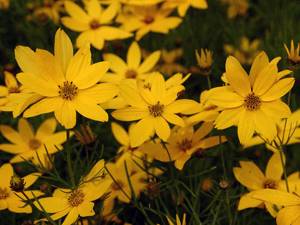
In the photo: Coreopsis flowering
Among the pests, aphids, which feed on the cell sap of the plant, pose a danger to coreopsis. Do not waste time treating flowers against aphids with folk remedies; immediately spray them with an insecticide solution. Sometimes coreopsis is parasitized by various beetles, which are best collected by hand.
Protection from pests and diseases
Although coreopsis is considered a fairly resistant plant, it does not have a 100% guarantee of protection from diseases and pests.
Common flower diseases:
- Rust is a fungal infection that causes brown spots to appear on leaves. Damaged parts of the plant must be removed. The remaining ones should be treated with fungicidal preparations.
- Spot is a viral disease that causes leaves to curl and stems to wilt. There is no cure for this infection. The infected bush will have to be removed from the site and burned.
- Fusarium is a fungal infection that is recommended to be treated with fungicides (Previkur, Fitosporin-M).
Of the pests, coreopsis is most often attacked by aphids and various beetles. Beetles can be removed by hand. To combat aphids, use an infusion of wood ash or a decoction of citrus peel. In advanced cases, it is better to resort to the help of insecticides (Aktara, Karbofos).
Diseases and pests of coreopsis
Coreopsis is susceptible to the following diseases and insect damage:
| Description of the problem | Cause | Fighting methods |
| Spotting. |
|
| Fusarium. |
|
| Rust. |
|
| Viral infection. |
|
| Aphid. |
|
| Damage by beetles and caterpillars. |
|
If you provide optimal conditions of detention and proper care, coreopsis will not be afraid of the listed lesions. To prevent insects from settling on a flower, it must be regularly inspected for the presence of their larvae.
Rules and methods of reproduction
There are several ways to propagate coreopsis. The most popular seed method. But it must be borne in mind that a plant cannot always retain all its species qualities (cross-pollination often occurs when several species are planted nearby). To ensure the preservation of maternal characteristics, other methods of reproduction are used.
Dividing the bush
It is better to carry out the procedure in the spring, when the ground is no longer frozen, but the plant has not yet begun to grow. It is good to dig around the shrub and remove it from the ground without damaging the roots. Using a clean, sharp knife or pruning shears, cut the rhizome into sections. Each should have 3-4 buds. Sprinkle the cut areas with wood ash. Allow to dry. Dig holes, add humus and sand to them. Place each piece in a separate hole, cover with soil, compact and water.
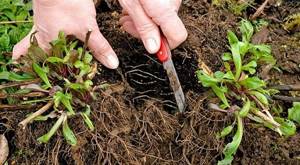
Cuttings
It is better to cut cuttings for planting in June-July. Coreopsis with strong, powerful stems is suitable. The shoot for cuttings should have many leaves. Cut each cutting 10 cm below the internode. Remove leaves from the lower part to prevent them from rotting in the ground. Treat the cuttings with Kornevin. Immerse 3 cuttings in containers with loose substrate. Water them well and move them to a bright place, but out of direct sun. Cover the top with film to prevent moisture from evaporating. Remove the film from time to time for ventilation. After rooting the cuttings, they can be transplanted to a permanent place.

Reproduction
Coreopsis are propagated by seeds, dividing the bush and cuttings.
Seeds
You can grow seedlings or sow seeds directly into the ground in spring or late autumn. But planting material collected from varietal plants will not most likely produce plants identical to the mother plant. Coreopsis can be pollinated by other varieties, species, or even representatives of the Chereda genus.
Dividing the bush
This is the easiest and most reliable way to breed coreopsis for amateur gardeners. Literally from one bush planted on a plot, in a few years you can get a whole flowerbed.
When transplanting, coreopsis just needs to be divided, but it takes root well.
By cuttings
There is no point in tinkering with cuttings for amateur gardeners. Species coreopsis easily reproduce by self-sowing, and varietal ones by dividing the bush. No matter how easily the cuttings take root, you won’t be able to simply stick them into the ground and forget, and you can get a whole plantation of flowers in a few years without any effort.
Transfer
Like most perennials, coreopsis is not recommended to be constantly grown in the same place. Once every 3-4 years he needs a transplant. This will not only change the soil to a more nutritious one, but also stimulate abundant flowering. It is better to replant in the spring. The overgrown bush is divided into parts. Damaged and dried stems are removed. Together with a lump of earth, the plant is transplanted to a well-lit place in a prepared hole. A little sand and compost are added to it.
Description of the Coreopsis flower
Coreopsis is a herbaceous plant or subshrub. The bushes are sparse. The root system is well developed. The pagons are always erect, graceful, 45-120 cm high, pubescent. The leaves are oppositely arranged, pinnately dissected or palmately divided.
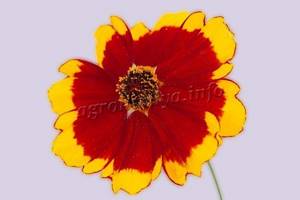
Photo of Coreopsis Drummondia flower
Flowering occurs from mid-summer to October. These are general frameworks - the time of flower appearance may vary significantly among different varieties. The inflorescences are large, basket-shaped, 3-8 cm in diameter. Buds have jagged petals. They can be single or terry. The color is usually golden, but there are also coreopsis with red, orange and pink flowers.
Interesting!
Seeds appear in seed pods after the crop blooms. They are quite small, similar to dark bugs.
Autumn care, seed collection and wintering
After flowering ends, oblong seed pods form in place of the flowers. Small seeds ripen in them. Before collecting them, the box must be allowed to dry and ripen. To prevent the seeds from spilling out on the ground, gauze bags are placed on the boxes.
In autumn, be sure to completely cut off the shoots, leaving no more than 10 cm above the ground surface. This will help preserve the root during wintering. If the winters in the region are not very severe and snowy, then the perennial coreopsis bush does not need to be covered with anything for the winter. But if there is a risk of early frosts and temperatures dropping to -20°C, the plant will need shelter. Fallen leaves, coniferous spruce branches, and humus can become insulation. In spring, it is important to remove the cover in time to avoid overheating of the roots.
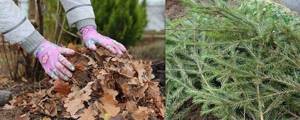
Perennial coreopsis is a popular flower for growing in open ground and is easy to care for. Perfect for those who don’t have enough time and knowledge to care for more capricious flowers. Thanks to its long flowering, coreopsis can decorate a flower garden until the cold weather.
More useful information about growing coreopsis from seeds through seedlings can be found after watching the video:
Planting and caring for coreopsis
- Planting: sowing annual seeds in the ground - in May, in a greenhouse - in mid-April, sowing perennial seedlings - in early March, transplanting seedlings into the ground - at the end of May.
- Flowering: from July to October.
- Lighting: bright sunlight, for some species partial shade is preferable.
- Soil: moist, loose, light, well-drained, not too fertile, neutral reaction.
- Watering: regular and moderate until the seedlings get stronger. Mature plants only need watering during drought.
- Fertilizing: with a solution of complex mineral fertilizer, but only when grown in poor soil.
- Reproduction: seeds, cuttings and dividing the bush.
- Diseases: leaf spot, rust and fusarium.
Read more about growing coreopsis below.










